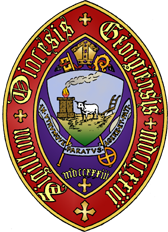Finding a successor for the Second Bishop of Georgia, the Rt. Rev. Bishop John Beckwith proved difficult. In May 1891, the convention of the Diocese of Georgia elected the Rev. Thomas F. Gailor, the Vice-Chancellor of the University of the South at Sewanee over two other candidates for bishop–the Rector of St. Paul’s, Augusta and the missionary bishop of North Texas. Gailor declined the election saying that he felt called to his work at the university.
That July, the convention met again with two bishops on the slate–the missionary bishop of Northern California and the missionary bishop of Wyoming and Idaho. Bishop Ethelbert Talbot was elected and a two-person delegation was sent to Laramie, Wyoming, to meet with him. For three days the Rev. F.F. Reese and Mr. W.K. Miller talked repeatedly with Talbot, who would neither accept nor reject the offer. Finally the delegation headed back to Georgia offering him an additional thirty days to make up his mind. In September, Bishop Talbot declined the call, writing to the Diocese of Georgia that he felt “deeply committed to the missionary operations of the Church in this new and growing West.”
 The convention reconvened on November 11 with four priests of the Diocese of Georgia on the slate along with the rector of Christ Church in Detroit, Michigan, and the Rev. Cleland Kinloch Nelson, rector of the Church of the Nativity in South Bethlehem, Pennsylvania. Nelson received majorities in both houses, with scattered votes for Johnson and the four Georgia clergy.
The convention reconvened on November 11 with four priests of the Diocese of Georgia on the slate along with the rector of Christ Church in Detroit, Michigan, and the Rev. Cleland Kinloch Nelson, rector of the Church of the Nativity in South Bethlehem, Pennsylvania. Nelson received majorities in both houses, with scattered votes for Johnson and the four Georgia clergy.
Nelson was consecrated as Bishop on February 24, 1892, in St. Lukes’ Church, Atlanta. That May he addressed the annual convention saying, “The proper attitude of the Church in Georgia is best described by the word aggressive…we, the Bishop and missionary clergy, are charged with the responsibility of awaking to life dormant stations and entering immediately upon a lively campaign in quarters where the Church has as yet no foothold.”
He named areas which needed “to be attacked (to use the warlike phrase proper to a militant church), and to be strongly manned.” These were Cordele, Abbeville, Tifton, Montezuma, Butler, Guyton, Tennile, Sandersville, Rockmart, and Jesup and he added beyond these were “a hundred other towns of 600 to 2,500 population” as a mission field.
With a practical view to the financial responsibilities which such an expansion would bring, in 1892 Bishop Nelson asked for, over and above regular annual missionary funds, $2,500 from each convocation, for a total of $10,000 (which is $317,700 in 2022 dollars). The missions themselves did contribute a total of almost $21,000 to the budget for their maintenance and improvement that same year. Georgia was at that time a largely missionary diocese, with just twenty-six parishes that were fully self-supporting out of a total number of 138 congregations.
Bishop Nelson chose Atlanta for his cathedral city, saying that the capital of the church should be in the capital of the state. St. Luke’s became the Diocese of Georgia’s first cathedral. Two years later the cathedral site was changed to St. Philip’s.
